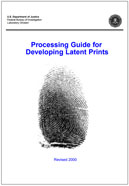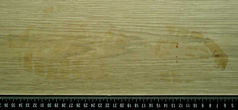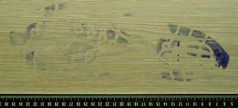|
View in browser: https://www.crime-scene-investigator.net/newsletter/1220.html
|
||
|
DECEMBER 2020 | ||
| ||
|
This Month's Featured Resource on the Crime Scene Investigator Network Website
|
||

The beginning of this manual is a list of processes and procedures for different surface types. Also included are processing sequences that specifically involve prints that are left in blood. Following these lists are details for each process that is currently implemented in the Latent Print Unit (LPU) of the Federal Bureau of Investigation (FBI) Laboratory. |
New CSI and Forensic Job Announcements
|
|
|
The most comprehensive listing of Crime Scene Investigation and Forensic To be notified of job openings as they are posted, follow us on Twitter: Job Posting Alerts |
||
|
Crime Scene Technician I & II
Chandler Police Department, Chandler, Arizona, USA Final Filing Date: December 20, 2020 A Crime Scene Technician I is an entry-level position to learn the techniques and practices of technical evidence collection and crime scene documentation. A Crime Scene Technician II will perform journey-level work with demonstrated expertise and knowledge in all forensic discipline areas including: evidence collection, chemical processing, photography, or latent fingerprint processing. <View complete job listing> |
||
|
Crime Scene Specialist
Marion County Forensic Services Agency, Indianapolis, Indiana, USA Final Filing Date: December 22, 2020 Responsible for forensic support in the identification, preservation and collection of forensic evidence at crime scenes, providing a wide variety of crime scene activities involving crimes against persons (homicides, suicides, rapes, aggravated assaults, etc.) to include, but not limited to, finger print processing, DNA collection/swabbing, and firearm evidence. <View complete job listing> |
||
|
Forensic Evidence Technician
County of Greenville, Greenville, South Carolina, USA Final Filing Date: December 31, 2020 Provides photographic documentation of crime scenes, collects, and preserves physical evidence. Performs a variety of types of analysis of evidence that may be collected at a crime scene in accordance with federal, state, and local laws and department/division policy. <View complete job listing> |
||
|
Evidence Technician
Lakewood Police Department, Lakewood, Washington, USA Final Filing Date: December 24, 2020 Under the direction of an Evidence Supervisor, the incumbent will perform a variety of technical duties in the gathering, processing, and identification of evidence in association with law enforcement. <View complete job listing> |
||
 |
||
|
Forensic Scientist Trainee
Mississippi Department of Public Safety, Pearl, Mississippi, USA Final Filing Date: December 28, 2020 This is an entry level position devoted to training in the assigned section. Employee carries out the requirements called for in the section's training program. Participates in training of chemical, instrumental, and microscopic techniques necessary to perform the required examinations. Participates in training of the principles that form the foundation of the science. Performs controlled practical exercises. Performs required reading assignments. <View complete job listing> |
||
|
Firearms / Tool Mark - Forensic Scientist 1
Idaho State Police, Coeur d'Alene, Idaho, USA Final Filing Date: December 30, 2020 A Forensic Scientist 1 position is an entry level position and is an approved under-fill for the Forensic Scientist 2 classification. Employ various methods of scientific analysis to make determinations regarding samples submitted as evidence in criminal cases or for individual characteristic database entry. Assume responsibility for and maintain the integrity of evidence. Interpret scientific data and ensure validity. Author and issue laboratory reports. <View complete job listing> |
||
|
Crime Lab Scientist 1
Georgia Bureau of Investigation, Decatur, Pooler, and Moultrie, Georgia, USA Final Filing Date: October 25, 2020 Under immediate supervision perform analytical procedures related to DNA analysis of biological samples for the GBI Crime Lab. Performs DNA analysis of physiological fluids for the purpose of identification and individualization. The type of material typically examined includes but is not limited to semen and saliva collected at crime scenes or from articles of physical evidence. <View complete job listing> |
||
|
Fingerprint Technician
Pennsylvania State Police, Harrisburg, Pennsylvania, USA Final Filing Date: December 28, 2020 Operating the Integra-ID device. Analyzing fingerprints based on image quality, pattern type, and the placement of core and axis. Conducting verifications of side-by-side fingerprint images to determine positive identification or non-identification. Assigning primary and reference pattern types to ten print submissions to ensure the accuracy of the Integra-ID search and storage processing. <View complete job listing> |
||
|
Search for more job listings in Crime Scene Investigations and Forensics To be notified of job openings as they are posted, follow us on Twitter: Job Posting Alerts |
||
|
Other Resources on the Crime Scene Investigator Network Website
|
||
|
Not Subscribed to this Newsletter?
|
||
|
If you are not subscribed to this newsletter, you may subscribe with this link: SUBSCRIBE via email |
||
|
To Unsubscribe
|
||
|
To unsubscribe from future e-mail alerts, please click here: UNSUBSCRIBE Copyright ©2020 Crime Scene Resources, Inc. Crime Scene Investigator Network |


 In the course of time I found myself confronted with a number of questions about how to improve shoeprints and fingerprints in blood. These questions arose because I learned about the increased use of Luminol for detecting and/or visualising blood traces in relation with DNA research. For this, the use of Leuco Crystal Violet (LCV) reagent to process and/or enhance traces found on non-porous materials has increased too. The reason for this is that LCV is easy to use. It can be applied without first fixing the blood trace. The formula of LCV already incorporates the fixing agent 5-sulfosalicylic acid. Also, LCV is colorless and only assumes a color once it reacts with blood. To prevent discoloring of the surface it is advised to rinse afterwards, at which point the visualized trace must be photographed immediately. Online searches into this issue of the chemical improvement of shoeprints and fingerprints in blood result in reports where the LCV reagent is recommended as a very good enhancement product for fingerprints and shoeprints in blood on non-porous surfaces.
In the course of time I found myself confronted with a number of questions about how to improve shoeprints and fingerprints in blood. These questions arose because I learned about the increased use of Luminol for detecting and/or visualising blood traces in relation with DNA research. For this, the use of Leuco Crystal Violet (LCV) reagent to process and/or enhance traces found on non-porous materials has increased too. The reason for this is that LCV is easy to use. It can be applied without first fixing the blood trace. The formula of LCV already incorporates the fixing agent 5-sulfosalicylic acid. Also, LCV is colorless and only assumes a color once it reacts with blood. To prevent discoloring of the surface it is advised to rinse afterwards, at which point the visualized trace must be photographed immediately. Online searches into this issue of the chemical improvement of shoeprints and fingerprints in blood result in reports where the LCV reagent is recommended as a very good enhancement product for fingerprints and shoeprints in blood on non-porous surfaces.

